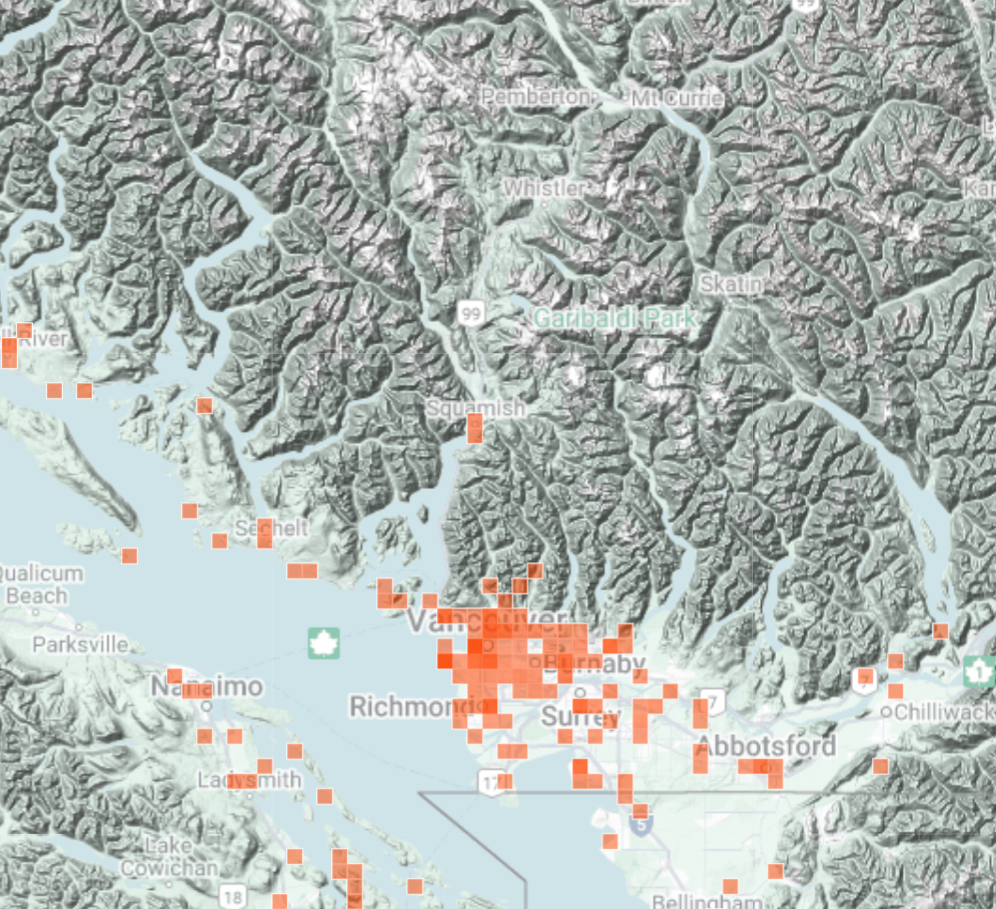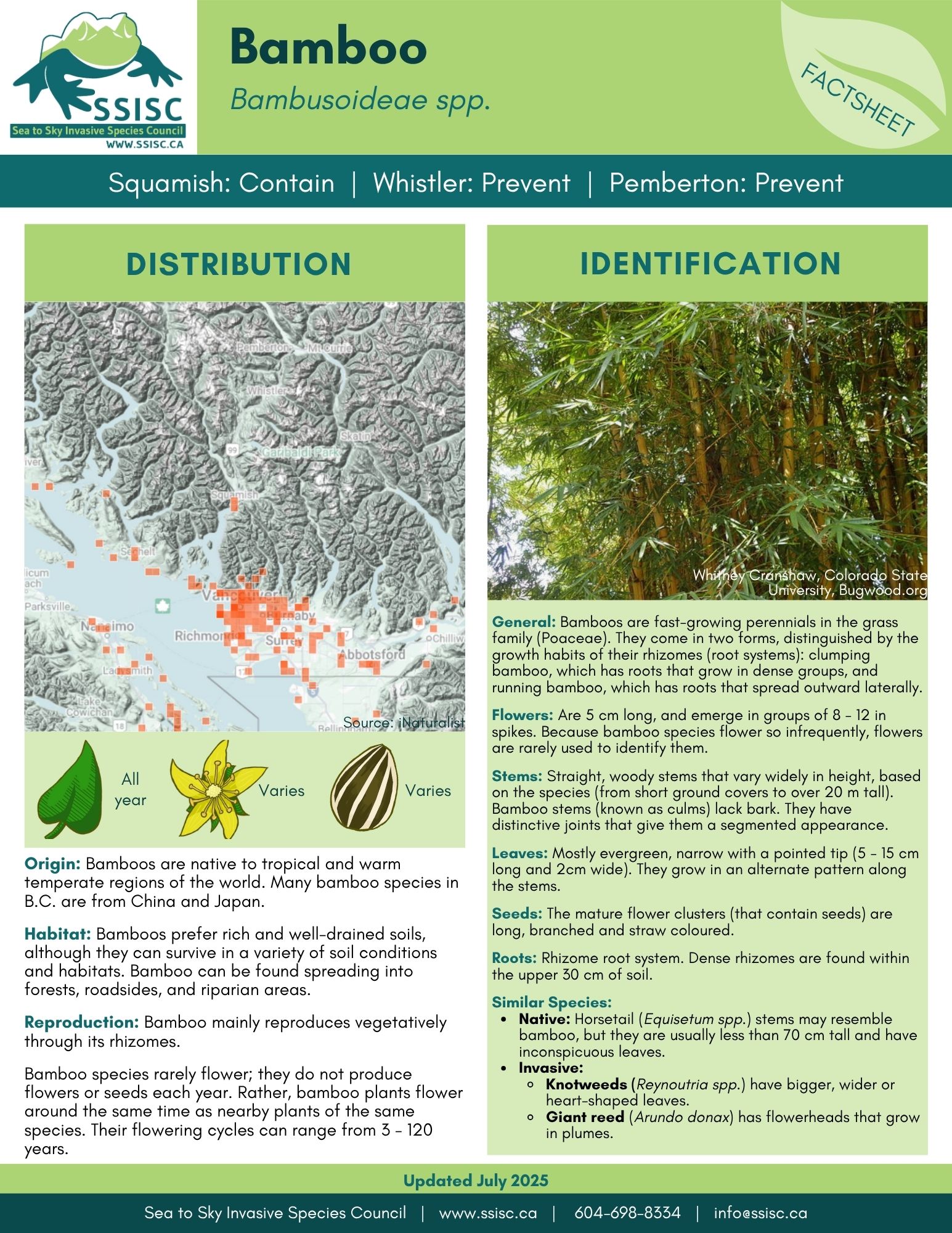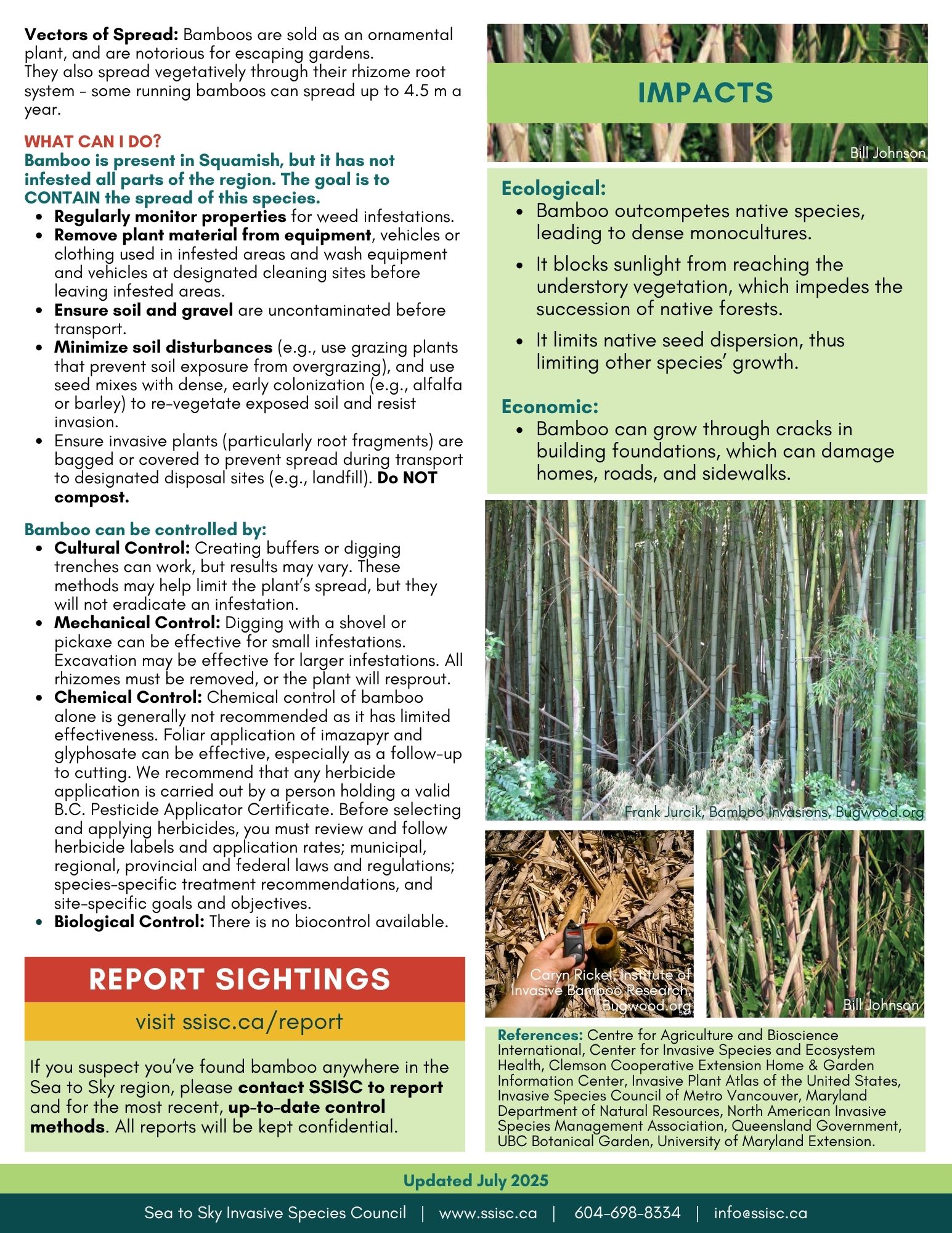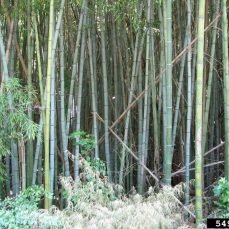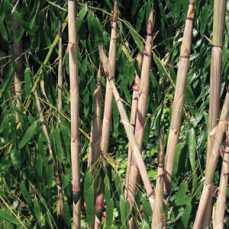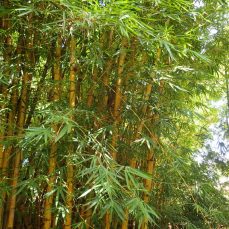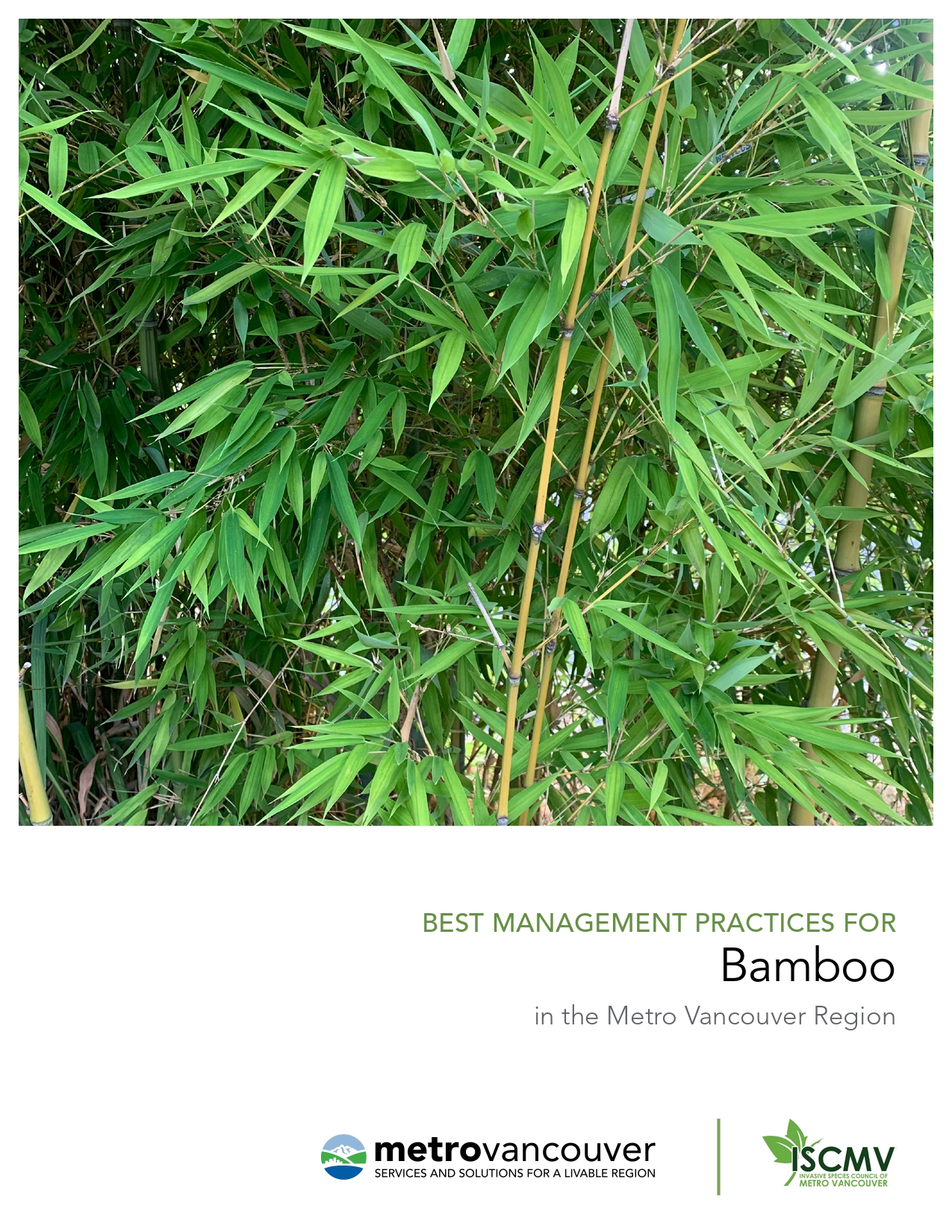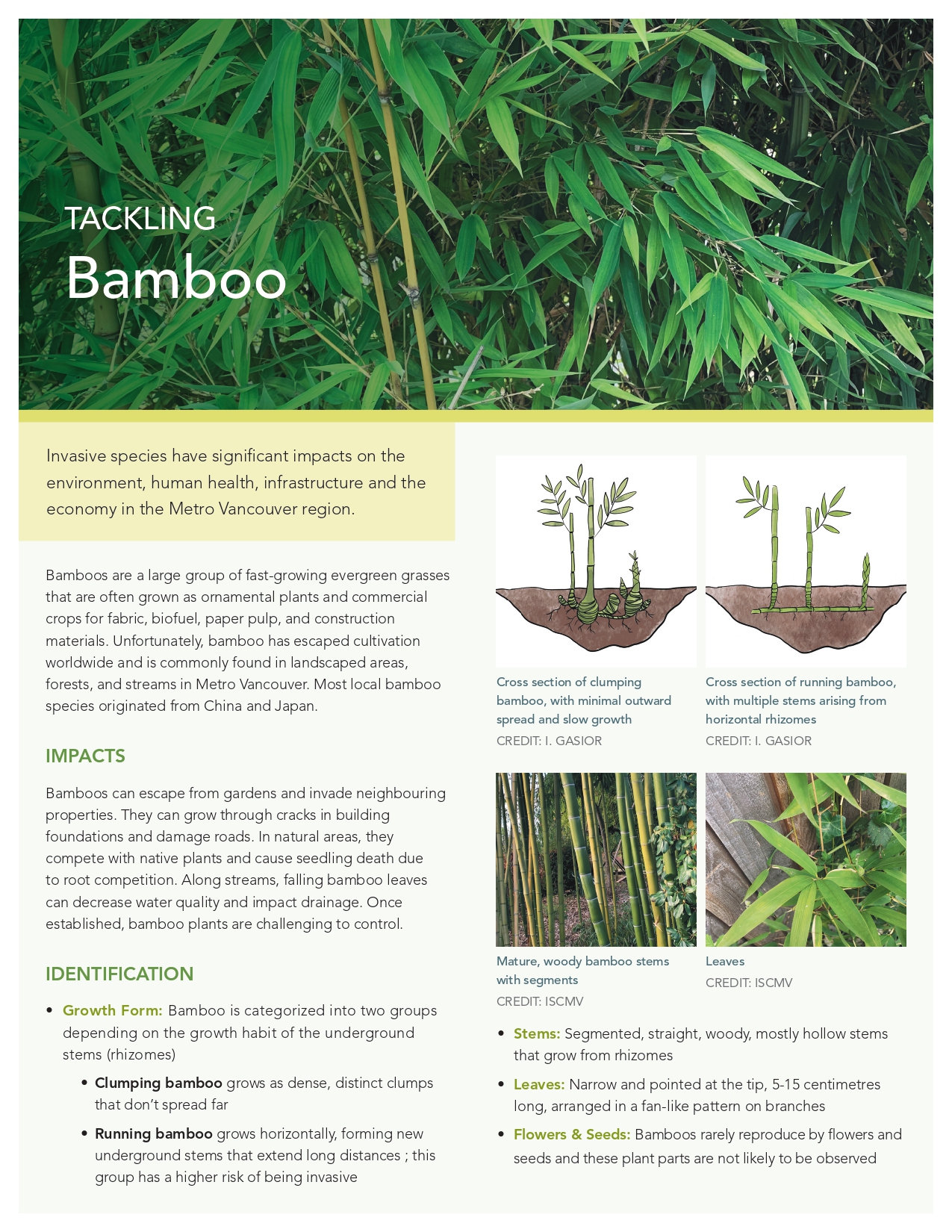
Photo Credit: Whitney Cranshaw, Colorado State University, Bugwood.org
ID Characteristics
General: Bamboos are fast-growing perennials in the grass family (Poaceae). They come in two forms, distinguished by the growth habits of their rhizomes (root systems): clumping bamboo, which has roots that grow in dense groups, and running bamboo, which has roots that spread outwards laterally.
Flowers: Are 5 cm long, and emerge in groups of 8 – 12 in spikes. Because bamboo species flower so infrequently, flowers are rarely used to identify them.
Stems: Straight, woody stems that vary widely in height, based on the species (from short ground covers to over 20 m tall). Bamboo stems (known as culms) lack bark. They have distinctive joints that give them a segmented appearance.
Leaves: Mostly evergreen, narrow with a pointed tip (5 – 15 cm long and 2cm wide). They grow in an alternate pattern along the stems.
Seeds: The mature flower clusters (that contain seeds) are long, branched and straw-coloured.
Roots: Rhizome root system. Dense rhizomes are found within the upper 30 cm of soil.
Similar Species
Native species
Horsetail (Equisetum species)
The stems without branches can resemble bamboo. Their stems are usually less than 70 cm tall, and their leaves are inconspicuous.

Invasive species
Knotweeds also have hollowed, segmented stems. Unlike bamboo, knotweed stems die by completely every winter. Knotweed leaves are larger and heart to triangular-shaped.
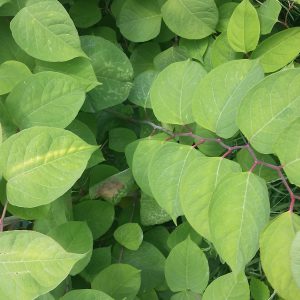
Giant reed (Arundo donax)
Like bamboo, giant reed has rhizomes and hollow culms. It has flowerheads that grow in plumes.

Exotic
Lucky bamboo (Dracaena sanderiana)
Lucky bamboo is not a true bamboo and only survives indoors. It is often available in single stems or braided/twisted into shapes.
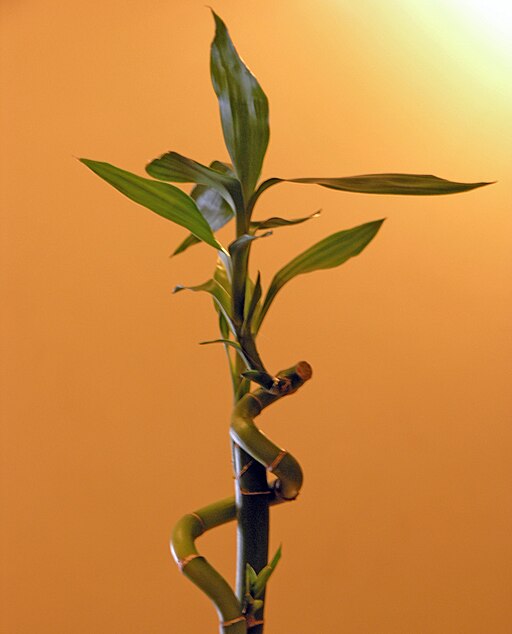
Photo: User SeanMack on en.wikipedia, CC BY-SA 3.0 <http://creativecommons.org/licenses/by-sa/3.0/>, via Wikimedia Commons
Habitat and Origin
Bamboos are native to tropical and warm temperate regions of the world. Many bamboo species in B.C. are from China and Japan.
Bamboos prefer rich and well-drained soils, although they can survive in a variety of soil conditions and habitats. Bamboo can be found spreading into forests, roadsides, and riparian areas.
How it Spreads
Bamboo mainly reproduces vegetatively through its rhizomes.
Bamboo species rarely flower; they do not produce flowers or seeds each year. Rather, bamboo plants flower around the same time as nearby plants of the same species. Their flowering cycles can range from 3 – 120 years.
Bamboos are sold as an ornamental plant, and are notorious for escaping gardens.
They also spread vegetatively through their rhizome root system – some running bamboos can spread up to 4.5 m a year.
Impacts
Ecological:
- Bamboo outcompetes native species, leading to dense monocultures.
- It blocks sunlight from reaching the understory vegetation, which impedes the succession of native forests.
- It limits native seed dispersion, thus limiting other species’ growth.
Economic:
- Bamboo can grow through cracks in building foundations, which can damage homes, roads, and sidewalks.
Prevent the Spread
Bamboo is found in certain portions of the Sea to Sky region (i.e. Squamish and south), but has not yet infested all potential habitats. The goal is to contain the spread of bamboo to ISMA 1.
Learn to identify bamboo: Use the images presented on this profile page.
What to do if you spot it: You can report any bamboo sighting by visiting our reporting page.
DO:
- Regularly monitor properties for weed infestations.
- Ensure soil and gravel are uncontaminated before transport.
- Quickly re-vegetate disturbed areas with fast-growing, competitive, native plants can limit the growth of bamboo and is a fundamental tool to limit its spread.
- Minimize soil disturbance in the area surrounding the infestation.
- Ensure plants (particularly flowering heads or root fragments) are bagged or covered to prevent spread during transport to designated disposal sites (e.g. landfill).
DO NOT:
- Plant bamboo in a garden, no matter how well-contained its enclosure may seem.
- Move soil that has been contaminated with bamboo.
- Unload, park, or store equipment or vehicles in infested areas; remove plant material from any equipment, vehicles, or clothing used in such areas and wash equipment and vehicles at designated cleaning sites before leaving infested areas.
- Compost bamboo, especially the roots!
Control
Cultural Control:
Creating buffers or digging trenches can work, but results may vary. These methods may help limit the plant’s spread, but they will not eradicate an infestation.
Mechanical Control:
Digging with a shovel or pickaxe can be effective for small infestations. Excavation may be effective for larger infestations. All rhizomes must be removed, or the plant will resprout.
Chemical Control:
Chemical control of bamboo alone is generally not recommended as it has limited effectiveness. Foliar application of imazapyr and glyphosate can be effective, especially as a follow-up to cutting.
We recommend that any herbicide application is carried out by a person holding a valid B.C. Pesticide Applicator Certificate. Before selecting and applying herbicides, you must review and follow herbicide labels and application rates; municipal, regional, provincial and federal laws and regulations; species-specific treatment recommendations, and site-specific goals and objectives.
Biological Control:
There is no biocontrol available.
Sea to Sky Distribution
Bamboo Factsheet
Having trouble viewing the factsheet? Don’t worry, all the information is included on this page. You can also contact us with any questions.
Additional Resources
References
- CABI, Common bamboo
- Center for Invasive Species and Ecosystem Health, Bamboos
- Clemson Cooperative Extension Home & Garden Information Center, Bamboo Control
- Invasive Plant Atlas of the United States, Golden Bamboo
- Invasive Species Council of Metro Vancouver, Best Management practices of bamboo
- Invasive Species Council of Metro Vancouver, Tackling Bamboo
- Maryland Department of Natural Resources, Invasive Plants and Insects of Maryland: Golden Bamboo
- North American Invasive Species Management Association, Spotlight on Golden Bamboo
- Queensland Government (Business Queensland), Bamboo
- Queensland Government (Business Queensland), Bamboo Factsheet
- UBC Botanical Garden, Bamboos
- University of Maryland Extension, Containing and Removing Bamboo


